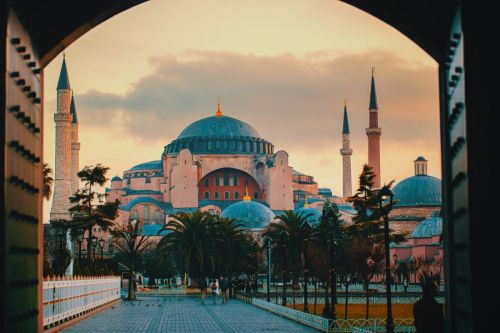Ephesus is probably the best-preserved ancient city in the Mediterranean. Founded in the most beautiful corners of Western Anatolia, during its heyday it was the capital of five hundred Anatolian cities. Today, although only ruins remain, it is once again teeming with life thanks to crowds of tourists visiting the places where Heraclitus lived centuries ago and Saint. Paul of Tarsus, where Saint John wrote his Gospel, and Jesus' mother found her home.
It is located between the cities of Izmir (formerly Smyrna) and Aydin.
According to the prophecy that Androclus received from the oracle before his expedition to Ionia, he should find a city in the place indicated by the fish and the boar. Near the mouth of the Kaystron River, on the hill of Pion, Androclus encountered fishermen roasting fish over a fire. One of the fish suddenly jumped and fell into the fire, which caused the scattering sparks to ignite the nearby bushes. A boar that had been hiding there jumped out of the burning bushes and the fire scared it away. Androclus already knew that for the prophecy to come true, he should find his city in this place.
It was probably founded as an Ionian city in the 9th century BC (some believe that in the 11th-14th centuries). The creation of the city is also attributed to the Amazons, who appear as its founders in several myths. The Amazons are said to have placed a wooden image of Artemis under an oak tree in Ephesus, around which they made sacrifices, danced war dances, and played songs. Foundations were built around this wooden statue. Artemis of Ephesus was called the Cretan Lady of Ephesus.
Situated at the mouth of the river, it developed as a port city and an important center of trade.
The most famous element of the philosophy of Heraclitus of Ephesus is the concept of change as the central element of the world (ta panta rhei - everything flows), as Heraclitus put it in the famous phrase "It is impossible to step into the same river twice."
The city was then captured by the king of Lydia (a historic land in western Asia Minor), Croesus, who rebuilt it. In 560 BC Ephesus came under Persian rule.
He was a leading representative of linear painting, and a master of psychological analysis and dramatic expression. He operated mainly in Athens.
The Ionian uprising was bloodily suppressed by Darius I the Great. Ephesus was not destroyed.
After the death of Alexander of Macedon, the rule in Ephesus was taken over by one of his generals, Lysimachus, who moved the city to a valley between the hills and built a new port and defensive walls.
It soon became the capital and an important trading center in the Roman Empire. It was one of the largest cities in the Mediterranean world, with a population of 250.000. people. It was then that almost all historical architectural structures were built, the ruins of which have been preserved to this day.
Probably 80-150 thousand Romans died then.
In the beliefs of many cultures, the Mother Goddess was the main deity in the pantheon. She was most often identified with the Earth (or her patron), and in many cultures, she was also the queen of heaven. She was the giver of all life, personified fertility and motherhood, and was often considered the mother of the gods.
Artemis was worshiped both as a Mother Goddess (her statue in Ephesus depicted a woman with countless breasts) and as an Eternal Virgin. Her cult was very strong. The Greeks considered this temple one of the seven wonders of the ancient world.
Also on this night, in Pella, the metropolis of Macedonia near Thessaloniki, Alexander of Macedon was born, who in his adult life felt great respect and respect for the Temple of Artemis. The inhabitants of Ephesus, however, had great respect for Alexander of Macedon, who at the age of 20 received the nickname "The Great". After the temple fire, when they were asked, "Why couldn't your Goddess protect her Temple from the fire?", the answer was, "Because our Goddess was then in Pelwa to be present at the birth of Alexander the Great."
He promised the Ephesians that he would cover all the expenses related to Artemis himself, but the proud Ephesians did not agree to this. They replied, "It does not suit a god-like Alexander the Great to build a temple for another god."
The figure of the Goddess was decorated with gold and shiny marbles that shimmered and glowed in the light. Today, all that remains of this majestic and colossal monument is a large ditch.
A conflict began between the Christian god and the pagan gods. One of the people involved in this conflict was Saint Paul of Tarsus, who probably visited Ephesus three times on his missionary mission and taught the Ephesians. A conflict of interests arose because the number of people adopting the new faith was systematically increasing, which affected the profits of local producers and sellers of devotional items related to the cult of Artemis.
While preaching by Saint Paul in the Grand Theater, one of the craftsmen, the jeweler Demetrius, who made miniatures of the temple of Artemis, having heard Paul's words that gods appointed by people cannot be "Gods" and cannot be "holy", organized a demonstration. Together with the outraged craftsmen, he stormed into the Grand Theater, shouting: "Artemis of Ephesus is great!" Confusion ensued, and several companions of St. Paul were kidnapped by the crowd. The local secretary, Saint, managed to calm down the situation. Paul had to leave Ephesus and go to Macedonia.
Saint Paul addressed one of his letters - the letter to the Ephesians - to the Christian community in Ephesus. The second letter to the Ephesians is found in the Book of Revelation.
Saint John supposedly brought Jesus' mother, Mary, from Jerusalem to Ephesus after Christ's crucifixion. In Ephesus, Coressus lived with her on the hill. Currently, there is a small chapel built on the foundations of the house where, according to legend, Mary lived. It is called the House of Maia the Virgin.
During excavations around the tomb of St. John, five small tombs were discovered. Together with the tomb of St. John, they form the sign of the cross. Coins from the second half of the 1st century were also found there, which proves that this place was visited by pilgrims. Saint's John tomb was not plundered (the temple of Artemis was plundered many times).
The silted estuary cut the city off from the sea, which resulted in its loss of economic importance. Due to the swamps, it became an unhealthy place where malaria spread. The inhabitants moved to the nearby Ayasuluk hill (now the city of Selcuk), and Ephesus never returned to its former glory. The city was also destroyed by earthquakes.
The Cave of the Seven Sleepers is a Byzantine-era necropolis located near the ruins of ancient Ephesus. It is related to a legend from early Christianity when Christians were persecuted by the Roman authorities. When Emperor Decius, known for persecuting Christians, came to Ephesus, he ordered the destruction of Christian temples and the worship of Roman gods. Seven Christian youths who did not want to betray their faith hid in a nearby cave. The Romans found the hiding place and walled up the entrance, hoping that the trapped people would starve to death. However, this did not happen, because the young men fell into a 200-year sleep. When the persecution of the Christians stopped, they woke up and returned to the city to buy something to eat. However, the coins they wanted to pay with have long been out of circulation. They also learned that Decius had died centuries ago. They told their story, which was immediately considered a miracle.
The basilica was modeled on the Constantinople Basilica of the Holy Apostles. At that time it was the main pilgrimage site of the Christian world. After the Arab invasion of the Byzantine Empire in 654-5, urban life began to center around the hill with the basilica. The temple was surrounded by walls, and a castle - a citadel - was built on the top of the hill. The invasion of the Seljuk Turks resulted in the transformation of the basilica into a mosque, and the tomb of Saint. John could only be accessed for a fee. After the invasion of Ayasoluk by the Mongol leader Tamerlane, the hill was destroyed and the basilica turned into rubble.
Work recently carried out thanks to the support of a religious foundation from Lima (a city in the USA in Ohio) led to the reconstruction of some of the columns and walls of the basilica.
It confirmed the dogmatic title of Mary as the Mother of God (Theotokos).
In the 15th century, the city was completely abandoned.
As a result of the work, the monuments of the ancient city were uncovered and partially reconstructed, and currently, the ruins are among the best-preserved urban complexes. They are visited by many tourists.
These include:












